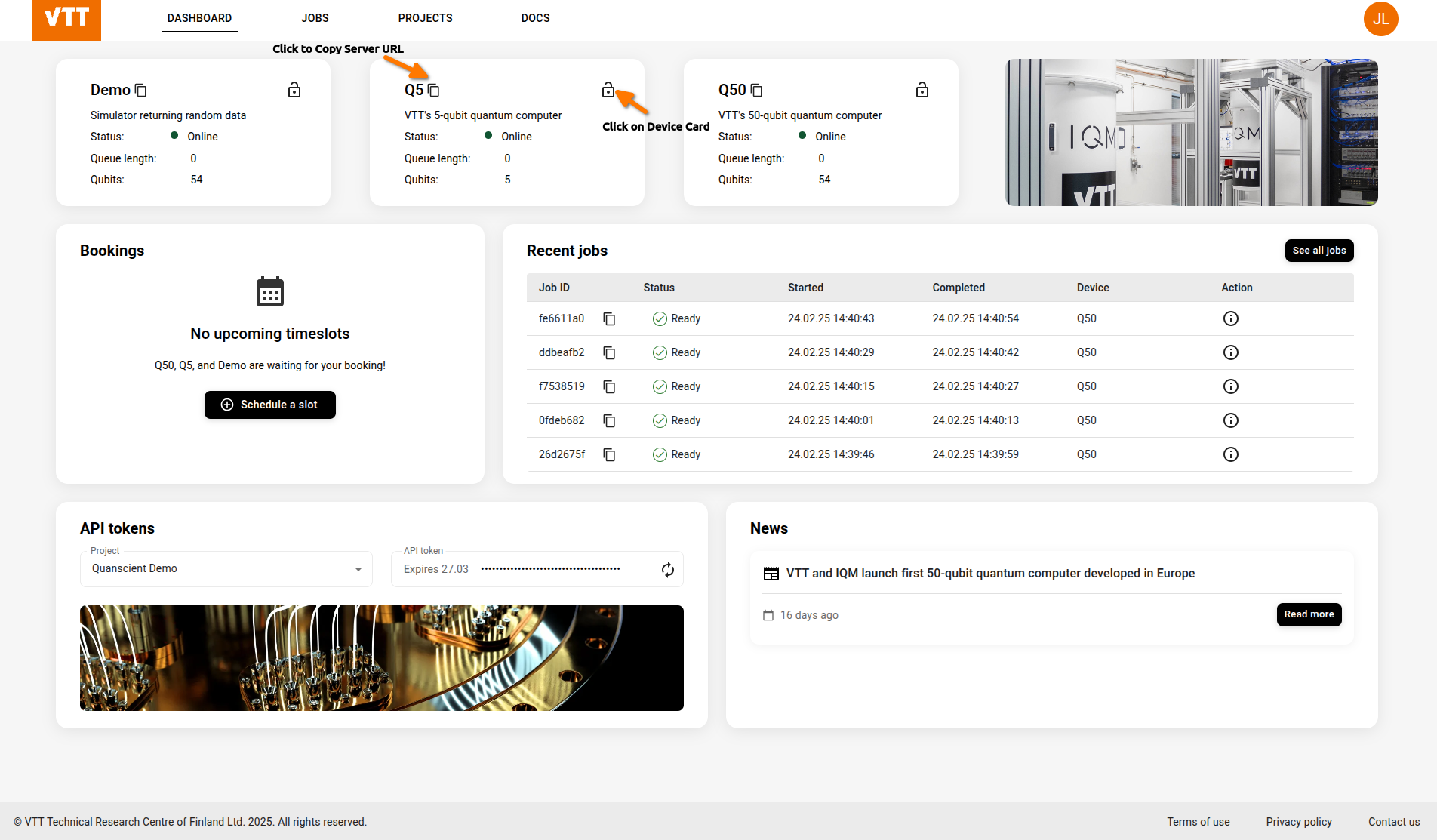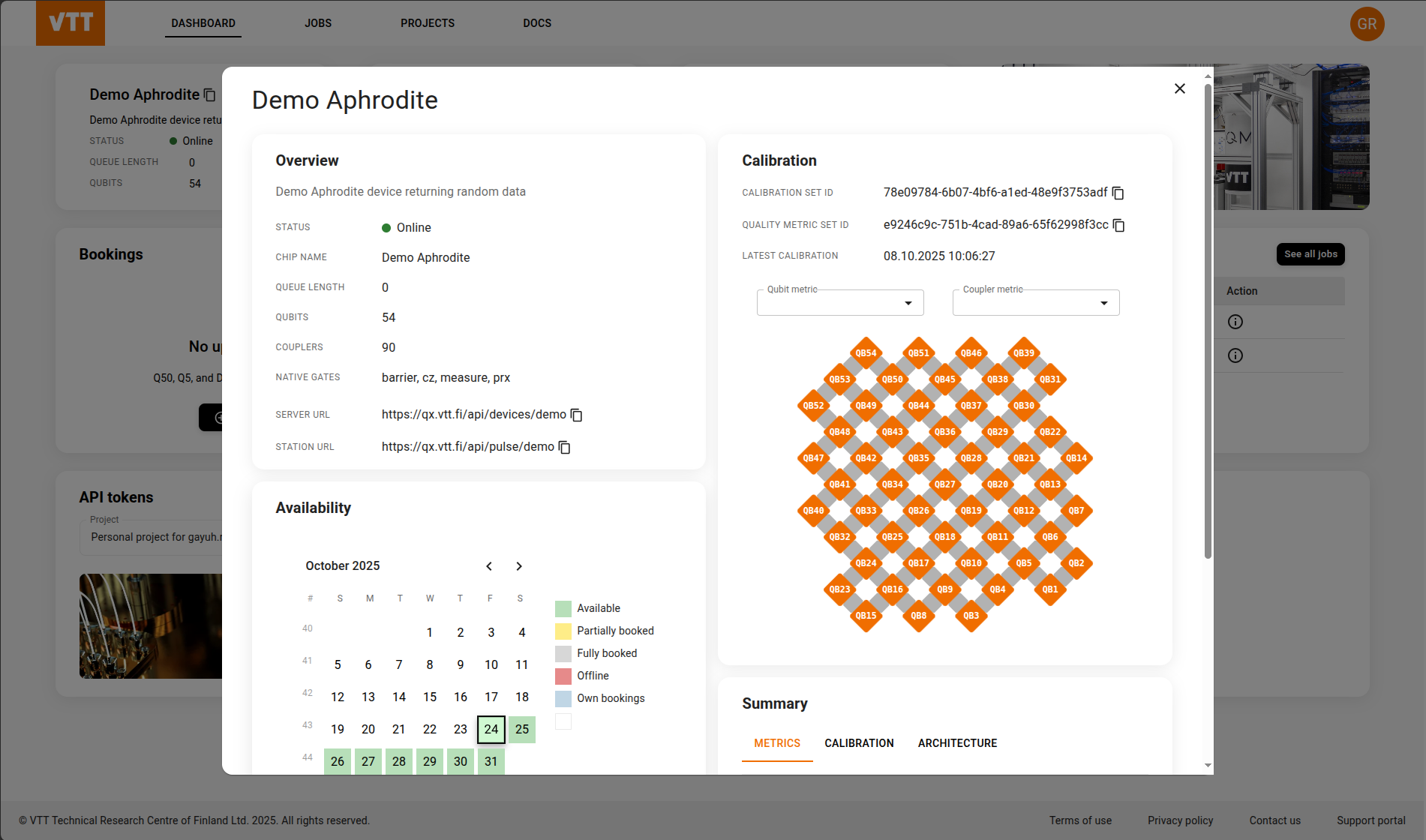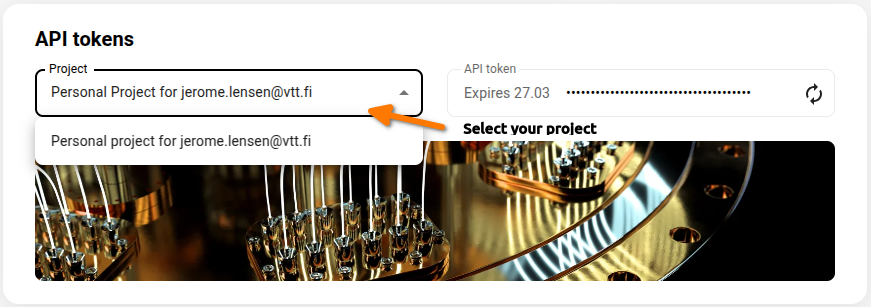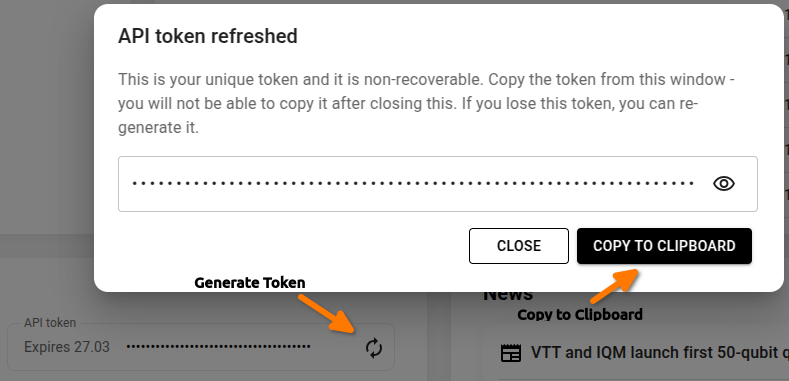import os
from iqm.qiskit_iqm import IQMProvider
from qiskit import QuantumCircuit, transpileExample: Using QX to Submit Jobs
This guide demonstrates how to submit quantum circuits to devices on QX. For detailed API documentation and additional resources, please refer to the IQM documentation.
Step 1: Installing Python library dependencies
This notebook requires a Python virtual environment with following libraries installed.
For specific client library versions, please refer to the device documentation:
The following packages listed below could be saved as requirements.txt:
iqm-client>=33.0.0,<34.0.0
matplotlib
pylatexenc
# For pulse level access
iqm-pulla>=12.0.0,<13.0.0iqm-client>=22.3,<23.0
qiskit-iqm>=17.3,<18.0
matplotlib
pylatexenc
# For pulse level access
iqm-pulla==5.28First, create a virtual Python environment with
conda create -n vttqx python=3.11 pip
conda activate vttqxThen install the dependencies. Refer to the device documentation pages above for the exact versions.
For Q50 & Demo:
pip install "iqm-client>=33.0.0,<34.0.0" "iqm-pulla>=12.0.0,<13.0.0" matplotlib pylatexencFor Q5:
pip install "iqm-client>=22.3,<23.0" "qiskit-iqm>=17.3,<18.0" iqm-pulla==5.28 matplotlib pylatexencIf you prefer using uv for faster installs and reproducible builds:
# Initialize a new project
uv init
# This creates a pyproject.toml file for project configuration
# Then installs dependencies, which will be recordedRefer to the device documentation pages above for the exact versions.
For Q50 & Demo:
uv add "iqm-client>=33.0.0,<34.0.0" "iqm-pulla>=12.0.0,<13.0.0" matplotlib pylatexencFor Q5:
uv add "iqm-client>=22.3,<23.0" "qiskit-iqm>=17.3,<18.0" iqm-pulla==5.28 matplotlib pylatexencOr install from existing requirements:
uv pip install -r requirements.txtStarting Jupyter Notebook
Install Jupyter in your conda environment:
conda activate vttqx
pip install notebook
# Start Jupyter Notebook
jupyter notebookInstall and run Jupyter in your uv-managed environment:
# First, activate your uv environment
source vttqx/bin/activate # On Windows: vttqx\Scripts\activate
# Install Jupyter
uv pip install notebook
# Start Jupyter Notebook
jupyter notebookThen we can import the IQM client library and the qiskit Python objects to define a quantum circuit
Step 2: Define your quantum circuit
Next, we define a quantum circuit that prepares a so called Bell state. In the first line we instantiate a QuantumCircuit object, that allocates two qubits. Further more, we give it the name Bell pair circuit.
circuit = QuantumCircuit(2, name="Bell pair circuit")
circuit.h(0) # Apply a Hadamard gate to the first qubit
circuit.cx(
0, 1
) # Apply a CNOT gate withfirst qubit as control qubit and second as target qubit
circuit.measure_all() # Finally, we add a measurement operation measuring all qubits
circuit.draw(output="mpl")Step 3. How to submit to VTT QX?
To submit to VTT QX, we have to instantiate the IQMProvider. The initialization method depends on which device you’re targeting:
For Q5 devices, the provider takes the full device URL as an argument. The URL should expose all needed API endpoints to fetch information about the target quantum computer. In the picture below, it is shown how to fetch the server URL for the Q5 quantum computer in the VTT QX UI.

server_url = "https://qx.vtt.fi/api/devices/q5"
provider = IQMProvider(server_url)For devices using IQM OS 4.4 (Demo and Q50), use the base URL with the quantum_computer parameter:
from iqm.qiskit_iqm import IQMProvider
from qiskit import QuantumCircuit, transpile, visualization
# For Demo device
provider = IQMProvider(
url="https://qx.vtt.fi",
quantum_computer='demo',
token="YOUR_API_TOKEN_HERE"
)
# OR for Q50 device
provider = IQMProvider(
url="https://qx.vtt.fi",
quantum_computer='q50',
token="YOUR_API_TOKEN_HERE"
)
backend = provider.get_backend()
# Create and run your circuit
qc = QuantumCircuit(3)
qc.h(0)
qc.cx(0, 1)
qc.cx(0, 2)
qc.measure_all()
qc_transpiled = transpile(qc, backend=backend)
job = backend.run(qc_transpiled, shots=1000)
result = job.result()
print(result.get_counts())
visualization.plot_histogram(result.get_counts())# For Q5 (continuing with the legacy method for this example)
server_url = "https://qx.vtt.fi/api/devices/q5"
provider = IQMProvider(server_url)Pulse Level Access
For users who need to submit pulse-level jobs, see the pulse level access example.
Pulse level access requires the station URL, which can be found on the device card as shown in the image below.

Generate project token
The provider allows us to generate a qiskit Backend object, that describes the quantum architecture that we are targeting. Knowing the details of the target quantum architecture is important for transpilation of our quantum circuits to the native gates and topology of the target device.
To instantiate the backend, the provider will make a call to the server_url, requesting information about the backend. VTT QX requires, that this call is authenticated. A user authenticates itself to VTT QX, by attaching a project token to each request. The project token can be copied from the dashboard in VTT QX.

Select the project as shown in the picture above. Next, navigate to the API tokens section and copy the token:

Note: If you don’t see any tokens listed in the API tokens section, you can generate a new token by clicking the refresh button (↻) in the API tokens area. This will create your first API token for the project.
Alternatively, you can generate a new project token by authenticating with an existing active project token. This method is useful when you already have access to a project and want to rotate or generate additional tokens. You can do this by using the following curl command:
curl 'https://qx.vtt.fi/api/projects/{project_id}/token' \
-X POST \
-H 'Authorization: Bearer <active_project_token>' \
-H 'Accept: application/json' \
-H 'Content-Type: application/json'Finally, paste the token into the cell below. The token is exposed to the IQM client via the environment variable IQM_TOKEN.
# Set the VTT QX token
os.environ["IQM_TOKEN"] = "<token-here>"
# Note, the token can also be passed directly to the client with out setting IQM_TOKEN
# provider = IQMProvider(server_url, token="<token-here>")Now, we can generate a backend object, which allows us to print more information about our target device
backend = provider.get_backend()
print(f"Native operations: {backend.operation_names}")
print(f"Number of qubits: {backend.num_qubits}")
print(f"Coupling map: {backend.coupling_map}")Before executing the circuit, we need to make sure that it only consists of native gates supported by the device
transpiled_circuit = transpile(circuit, backend)Finally, we can also submit the quantum circuit that we defined at the beginning and print the results
for _ in range(1):
job = backend.run(transpiled_circuit)
counts = job.result().get_counts()
print(counts)Fetching results for large jobs
For jobs with results larger than 50MB, the system automatically converts raw shots to counts. To retrieve these optimized results, use the IQM client’s get_run_counts() method:
from iqm.iqm_client import IQMClient
# Initialize the IQM client
client = IQMClient(url=server_url, token=os.environ["IQM_TOKEN"])
# Get the job ID from your submitted job
job_id = job.job_id()
# Fetch the counts using the IQM client
counts = client.get_run_counts(job_id)This approach ensures efficient memory usage and faster data retrieval for large-scale quantum experiments.
Step 4: Inspecting job results in VTT QX
VTT QX exposes additional information about the job in the UI.

Optional: Submitting with Cirq
IQM Cirq user guide can be found here: IQM-Cirq
⚠️ ⚠️ Cirq is not as well supported by IQM as Qiskit ⚠️ ⚠️
Compatible versions:
cirq-iqm 15.3
cirq-core 1.4.1import cirq
from iqm.cirq_iqm import Adonis
adonis = Adonis()
# Print metadata about the chip
print(adonis.metadata.qubit_set)
print(adonis.metadata.gateset)
print(adonis.metadata.nx_graph)# Define a test circuit with 2 qubits
q1, q2 = cirq.NamedQubit("Alice"), cirq.NamedQubit("Bob")
circuit = cirq.Circuit()
circuit.append(cirq.X(q1))
circuit.append(cirq.H(q2))
circuit.append(cirq.CNOT(q1, q2))
circuit.append(cirq.measure(q1, q2, key="m"))
print(circuit)from iqm.cirq_iqm.iqm_sampler import IQMSampler
# Decompose circuit to native gate set
decomposed_circuit = adonis.decompose_circuit(circuit)
# Map logical qubits to physical qubits and insert SWAP gates where needed
routed_circuit_1, initial_mapping, final_mapping = adonis.route_circuit(
decomposed_circuit
)
# Use the `IQMSampler` class to perform authenticated circuit submission
sampler = IQMSampler(server_url)
result = sampler.run(routed_circuit_1, repetitions=10)
print(result.measurements["m"])